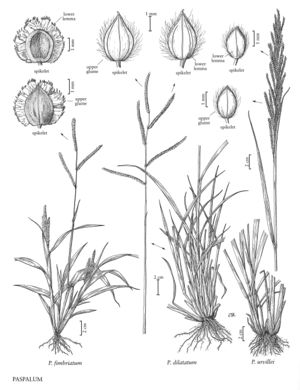Difference between revisions of "Paspalum urvillei"
FNA>Volume Importer |
imported>Volume Importer |
||
| (5 intermediate revisions by 2 users not shown) | |||
| Line 4: | Line 4: | ||
|publications= | |publications= | ||
|common_names=Vaseygrass | |common_names=Vaseygrass | ||
| + | |special_status={{Treatment/ID/Special_status | ||
| + | |code=I | ||
| + | |label=Introduced | ||
| + | }} | ||
|basionyms= | |basionyms= | ||
|synonyms= | |synonyms= | ||
| Line 26: | Line 30: | ||
-->{{#Taxon: | -->{{#Taxon: | ||
name=Paspalum urvillei | name=Paspalum urvillei | ||
| − | |||
|authority=Steud. | |authority=Steud. | ||
|rank=species | |rank=species | ||
| Line 33: | Line 36: | ||
|basionyms= | |basionyms= | ||
|family=Poaceae | |family=Poaceae | ||
| + | |illustrator=Linda A. Vorobik;Cindy Roché | ||
| + | |illustration copyright=Utah State University | ||
|distribution=Puerto Rico;Tenn.;Okla.;Miss.;Tex.;La.;Calif.;Ala.;Kans.;N.C.;S.C.;Va.;Pacific Islands (Hawaii);Ga.;Ky.;Fla.;Mo.;Ark. | |distribution=Puerto Rico;Tenn.;Okla.;Miss.;Tex.;La.;Calif.;Ala.;Kans.;N.C.;S.C.;Va.;Pacific Islands (Hawaii);Ga.;Ky.;Fla.;Mo.;Ark. | ||
|reference=None | |reference=None | ||
|publication title= | |publication title= | ||
|publication year= | |publication year= | ||
| − | |special status= | + | |special status=Introduced |
| − | |source xml=https:// | + | |source xml=https://bitbucket.org/aafc-mbb/fna-data-curation/src/200273ad09963decb8fc72550212de541d86569d/coarse_grained_fna_xml/V25/V25_1458.xml |
|subfamily=Poaceae subfam. Panicoideae | |subfamily=Poaceae subfam. Panicoideae | ||
|tribe=Poaceae tribe Paniceae | |tribe=Poaceae tribe Paniceae | ||
Latest revision as of 17:57, 11 May 2021
Plants perennial; cespitose, with a knotty base composed of very short (less than 1 cm) rhizomes. Culms 50-220 cm, erect; nodes glabrous or pubescent. Sheaths glabrous or pubescent; ligules 1-4(7.7) mm; blades 12-60 cm long, 2-12 mm wide, flat, mostly glabrous, a few long hairs near the base of the adaxial surface. Panicles terminal, with (4)10-30 racemosely arranged branches; branches 1.2-11.5 cm, divergent; branch axes 0.5-1.1 mm wide, winged, glabrous, margins scabrous, terminating in a spikelet. Spikelets 1.8-2.8 mm long, 1.1-1.5 mm wide, paired, appressed to the branch axes, elliptic to slightly obovate, stramineous (rarely purple). Lower glumes absent; upper glumes and lower lemmas 3-veined, margins pilose; upper florets stramineous. Caryopses 1.2-1.7 mm, white. 2n = 40.
Distribution
Puerto Rico, Tenn., Okla., Miss., Tex., La., Calif., Ala., Kans., N.C., S.C., Va., Pacific Islands (Hawaii), Ga., Ky., Fla., Mo., Ark.
Discussion
Paspalum urvillei has been introduced to the United States from South America. In the Flora region it grows in disturbed, moist to wet areas, primarily in the southeastern United States.
Selected References
None.
